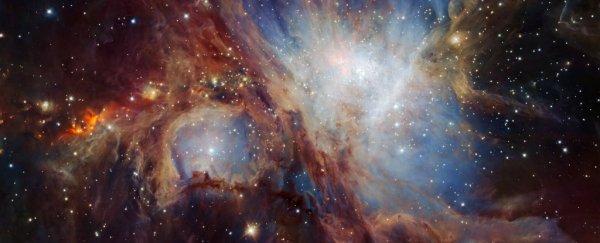An international team of astronomers working with the European Southern Observatory's Very Large Telescope (VLT) has captured the deepest and most stunningly detailed image of the Orion Nebula to date.
Besides its jaw-dropping beauty, the image also reveals that the nebula is full of brown dwarfs - low-mass objects that failed to become stars - which might shed new light on stellar production inside the region.
"This new image has caused excitement because it reveals [an] unexpected wealth of very-low-mass objects, which in turn suggests that the Orion Nebula may be forming proportionally far more low-mass objects than closer and less active star formation regions," the team explains.
Most of us are used to thinking of Orion as the human-shaped constellation we see in the night sky, but the Orion Nebula makes up just the middle 'star' on the sword of Orion - and it's not a star at all, it's a vast nursery where stars are born.
At around 1,350 light-years away, it's also the closest region of massive star formation to Earth, but this new image suggests we might still have a lot to learn about how the nebula 'gives birth' to new stars.
The photo was captured by the VLT's HAWK-I infrared instrument, which allows astronomers to peer through dust and debris to see stars and planets with lower temperatures that other instruments cannot see, resulting in a clean, crisp image of objects super far away from Earth.
With HAWK-I, the current team was able to peer through the gases that surround the Orion Nebula to examine brown dwarfs, massive objects that are bigger than gas giants but not massive enough to sustain nuclear fusion and become a star.
 ESO
ESO
"Understanding how many low-mass objects are found in the Orion Nebula is very important to constrain current theories of star formation," said team member Amelia Bayo, from the University of Valparaíso in Chile. "We now realise that the way these very low-mass objects form depends on their environment."
The team's findings suggest that brown dwarfs might be more common than previously thought, though the technology to fully examine them will not be available until the European Extremely Large Telescope (E-ELT) starts operation in 2024.
"Our result feels to me like a glimpse into a new era of planet and star formation science," said lead scientist Holger Drass, from the Astronomisches Institut in Germany. "The huge number of free-floating planets at our current observational limit is giving me hope that we will discover a wealth of smaller Earth-sized planets with the E-ELT."
This isn't the first time researchers have used HAWK-I to tug out some of the mysteries of the Universe. Back in 2010, it helped capture the structure of spiral galaxies.
"HAWK-I helped to explain the spiral structure of galaxies," said Petr Kabath, from the Paranal Observatory, who maintains HAWK-I but wasn't involved in the latest study. "Furthermore, it has unveiled the mystery of exoplanetary atmospheres and was also monitoring distant galaxies for supernovae explosions . . . And that is just a fraction of HAWK-I's achievements!"
The team's findings were recently published in the journal Monthly Notices of the Royal Astronomical Society.
